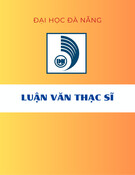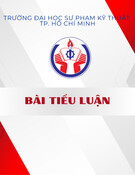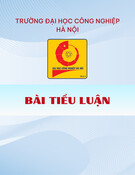
1
QT6.2/KHCN1-BM22
TRƯỜNG ĐẠI HỌC TRÀ VINH
HỘI ĐỒNG KHOA HỌC
BÁO CÁO TỔNG KẾT
ĐỀ TÀI NGHIÊN CỨU KHOA HỌC CẤP TRƯỜNG
KỸ THUẬT THỦY VÂN TRONG XÁC NHẬN
BẢN QUYỀN SỐ
Chủ nhiệm đề tài: TS. NGUYỄN THÁI SƠN
Chức danh: Giảng viên
Đơn vị: Khoa Kỹ thuật và Công nghệ
Trà Vinh, ngày 02 tháng 08 năm 2017
ISO 9001 : 2008

2
TRƯỜNG ĐẠI HỌC TRÀ VINH
HỘI ĐỒNG KHOA HỌC
BÁO CÁO TỔNG KẾT
ĐỀ TÀI NGHIÊN CỨU KHOA HỌC CẤP TRƯỜNG
KỸ THUẬT THỦY VÂN TRONG XÁC NHẬN
BẢN QUYỀN SỐ
Xác nhận của cơ quan chủ quản
(Ký, đóng dấu, ghi rõ họ tên)
Chủ nhiệm đề tài
(Ký, ghi rõ họ tên)
Nguyễn Thái Sơn
Trà Vinh, ngày 02 tháng 08 năm 2017
ISO 9001 : 2008

3
TÓM TẮT
Xác nhận bản quyền số thuận nghịch thu hút được nhiều sự quan tâm của các nhà
khoa học do kỹ thuật này có khả năng khôi phục lại dữ liệu gốc của những ảnh
mang tin mà không có bất kỳ thay đổi nào sau khi được xác nhận. Trong đề tài này,
chúng tôi đưa ra một giải pháp xác nhận bản quyền số thuận nghịch mới dựa vào
tiên đoán hình thoi và đánh giá độ phức tạp. Để đảm bảo chất lượng ảnh đã mang
tin cao và đạt được độ chính xác cao trong kiểm tra giả mạo, đánh giá độ phức tạp
được thực hiện trên mỗi điểm ảnh. Sau đó, những lỗi tiên đoán được tín toán dựa
vào tiên đoán hình thôi cho việc giấu mã xác nhận. Kết quả thực nghiệm thể hiện
rằng giải pháp đề xuất có khả năng khôi phục lại phiên bản gốc của ảnh chủ. Ngoài
ra, giải pháp đề xuất còn đạt được các hiệu quả tốt hơn so với các giải pháp trứơc
xết về mặt kiểm tra giả mạo và chất lượng ảnh.
Reversible image authentication attracts much attention of researchers since such
technique has ability to reconstruct the original version of the host image losslessly
after image authentication. In this paper, we propose a new reversible image
authentication based on rhombus prediction and local complexity. To maintain
good quality of stego images and to achieve high accuracy of tamper detection, the
local complexity of each pixel is first evaluated, then, the prediction error is
calculated by using rhombus prediction for embedding the authentication code.
Experimental results demonstrated that the proposed scheme has ability to recover
the original version of the host images. In addition, the proposed scheme obtains
better performance than previous schemes in terms of tamper detection and image
quality.

4
MỤC LỤC
LỜI CẢM ƠN ......................................................................................................... 7
PHẦN MỞ ĐẦU ..................................................................................................... 8
1. Tính cấp thiết của đề tài ............................................................................... 8
2. Tổng quan nghiên cứu.................................................................................. 8
3. Mục tiêu....................................................................................................... 9
4. Đối tượng, phạm vi và phương pháp nghiên cứu ........................................ 10
PHẦN NỘI DUNG ............................................................................................... 11
CHƯƠNG 1. Giải pháp đề xuất........................................................................ 11
CHƯƠNG 2. So sánh và đánh giá kết quả thực nghiệm của giải pháp mới được
đề xuất 17
PHẦN KẾT LUẬN ............................................................................................... 25
TÀI LIỆU THAM KHẢO ..................................................................................... 26

5
DANH MỤC BẢNG BIỂU
Table 1. Embedding capacity (bits) under different thresholds ........................................ 17
Table 2. Visual quality (dB) under different thresholds ................................................... 17
Table 3. Performance comparison of the proposed scheme and Lo and Hu’s scheme for the
tamper object A1 ............................................................................................................. 20
Table 4. Performance comparison of the proposed scheme and Lo and Hu’s scheme for the
tamper object B1 ............................................................................................................. 20
Table 5. Performance comparison of the proposed scheme and Lo and Hu’s scheme for the
tamper object C1 ............................................................................................................ 21
Table 6. Performance comparison of the proposed scheme and Lo and Hu’s scheme for the
tamper object D1 ............................................................................................................. 22
Table 7. Performance comparison of the proposed scheme with previous image
authentication schemes .................................................................................................... 23


![Báo cáo Thực tập cơ bản môn học: [Hướng dẫn chi tiết/Mẫu chuẩn]](https://cdn.tailieu.vn/images/document/thumbnail/2025/20251014/daidung488@gmail.com/135x160/40541760410916.jpg)























